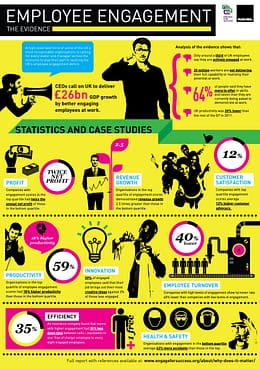
Our Nailing the Evidence working group published The Evidence in November 2012.
The UK has an employee engagement deficit. Survey after survey indicates that only around one third of UK workers say they are engaged – a figure that leaves the UK ranked ninth for engagement levels amongst the world’s twelfth largest economies as ranked by GDP (Kenexa 2009).
The UK also has a productivity deficit. The most recent ONS survey found that output per hour in the UK was 15 percent below the average for the rest of the G7 industrialised nations in 2011; on an output per worker basis, UK productivity was 20 percent lower than the rest of the G7 in 2011. This represents the widest productivity gap since 1995.
We believe these two factors are related. As the Evidence paper demonstrates, there is a firm correlation between employee engagement and high organisational productivity and performance, across all sectors of the economy.
The Problem:
Employee disengagement is therefore clearly contributing to our disappointing productivity figures. Analysis indicates that were the UK to move its engagement levels to the middle of the top quartile such as that for the Netherlands this would be associated with a £25.8bn increase in GDP (Kenexa).
MAJOR PRIORITY
No wonder then that increasing employee engagement is seen as a major priority by UK leaders. In the latest CBI Harvey Nash employment trends survey (July 2012) securing high levels of employee engagement was the top workforce priority for UK businesses, ahead even of containing labour costs. This year the Head of the Civil Service identified increasing engagement among public sector employees as a priority.
STATISTICAL IMPORTANCE OF ENGAGEMENT
This paper highlights the evidence for the effectiveness of employee engagement strategies in improving performance, productivity and, in the private sector, profitability.
This evidence comes from academic research, and from research using data compiled by research houses such as Towers Watson, Kenexa, Hay, Aon Hewitt and Gallup. It comes from case studies compiled by many leading companies and organisations.
The cumulative effect of these different studies leaves little room for doubt about the statistical importance of engaging employees. But the evidence also comes from our own experiences of working in organisations that care about engaging and inspiring their employees – and the effect that has on performance.
ENGAGEMENT IMPACT
As well as performance and productivity, employee engagement impacts positively on levels of absenteeism, on retention, on levels of innovation, on customer service, on positive outcomes in public services and on staff advocacy of their organisations.
It is also clear that engagement impacts more on performance than the other way around. A study in a leading retail bank found that employee engagement levels predicted subsequent business level performance over a three year horizon while business unit performance predicted engagement only over a single year.
No wonder that 94% of the world’s most admired companies believe that their efforts to engage their employees have created a competitive advantage (Hay).
DOWNLOAD ThE REPORT
Engage for Success acknowledges the following people for the production of this paper:
Bruce Rayton - University of Bath School of Management

Tanith Dodge, Gillian D'Analese - Marks and Spencer plc

